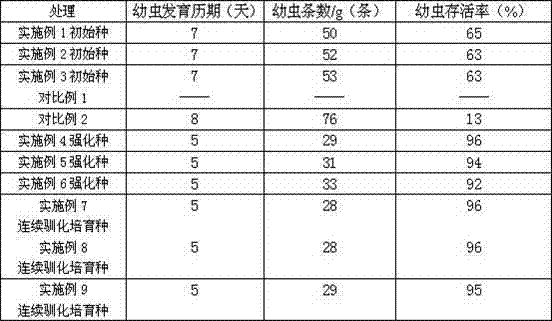Cultivation method of nicotine-resistant lucilia sericata strain
A technology of Lucilia sericata and its breeding method, which is applied in the field of insect breeding, can solve the problems of lack of nicotine-resistant Lucilia sericata species, and achieve the effects of proper nutritional components, smooth growth and good stability
- Summary
- Abstract
- Description
- Claims
- Application Information
AI Technical Summary
Problems solved by technology
Method used
Image
Examples
Embodiment 1
[0040] Example 1 Screening of nicotine-resistant Lucilia sericata varieties from wild Lucilia sericata varieties
[0041] S01. When the weather is fine, prepare the trapping culture material, the trapping culture material is composed of the following components in weight percentage: bran 90%, imported fish meal 10%, and the above-mentioned The formulation is adjusted to a humidity of 60%.
[0042] S02. Put the culture material prepared above into a square plastic pot per 1 kg (length*width*height=45cm*30cm*12cm). At 8:00 in the morning on the same day, the plastic pots containing the culture material were placed next to a domestic garbage dump, and at 17:00 in the afternoon, the plastic pots were taken back and brought back to the indoor cultivation.
[0043] S03. Under indoor conditions (temperature 25°C, humidity 30%), cultivate the trapped wild fly eggs until the larvae are mature, and use the behavior of the food-free period of Lucilia sericata to separate the fly maggo...
Embodiment 2
[0046] Example 2 Screening of nicotine-resistant Lucilia sericata varieties from wild Lucilia sericata varieties
[0047] S01. When the weather is fine, prepare the trapping culture material, which is composed of the following components in weight percentage: 80% bran, 20% imported fish meal, and the above-mentioned The formulation is adjusted to a humidity of 60%.
[0048] S02. Put the culture material prepared above into a square plastic pot per 1 kg (length*width*height=45cm*30cm*12cm). At 8:00 in the morning on the same day, the plastic pots containing the culture material were placed next to a domestic garbage dump, and at 17:00 in the afternoon, the plastic pots were taken back and brought back to the indoor cultivation.
[0049] S03. Under indoor conditions (temperature 25°C, humidity 30%), cultivate the trapped wild fly eggs until the larvae are mature, and use the behavior of the food-free period of Lucilia sericata to separate the fly maggots from the formula (i....
Embodiment 3
[0052] Example 3 Screening of nicotine-resistant Lucilia sericata varieties from wild Lucilia sericata varieties
[0053] S01. When the weather is fine, prepare the trapping culture material, which is composed of the following components in weight percentage: 70% of bran, 30% of imported fish meal, and the above-mentioned The formulation is adjusted to a humidity of 60%.
[0054] S02. Put the culture material prepared above into a square plastic pot per 1 kg (length*width*height=45cm*30cm*12cm). At 8:00 in the morning on the same day, the plastic pots containing the culture material were placed next to a domestic garbage dump, and at 17:00 in the afternoon, the plastic pots were taken back and brought back to the indoor cultivation.
[0055] S03. Under indoor conditions (temperature 25°C, humidity 30%), cultivate the trapped wild fly eggs until the larvae are mature, and use the behavior of the food-free period of Lucilia sericata to separate the fly maggots from the formu...
PUM
 Login to View More
Login to View More Abstract
Description
Claims
Application Information
 Login to View More
Login to View More - R&D
- Intellectual Property
- Life Sciences
- Materials
- Tech Scout
- Unparalleled Data Quality
- Higher Quality Content
- 60% Fewer Hallucinations
Browse by: Latest US Patents, China's latest patents, Technical Efficacy Thesaurus, Application Domain, Technology Topic, Popular Technical Reports.
© 2025 PatSnap. All rights reserved.Legal|Privacy policy|Modern Slavery Act Transparency Statement|Sitemap|About US| Contact US: help@patsnap.com

